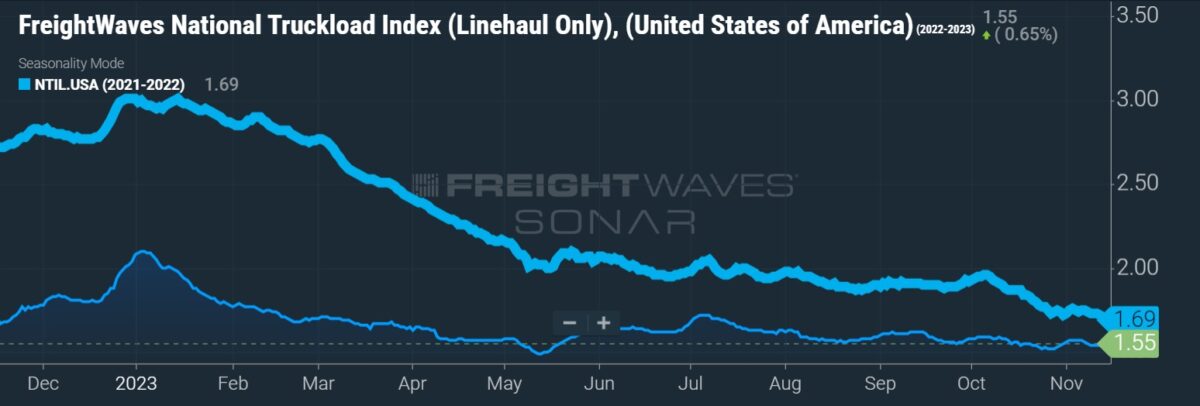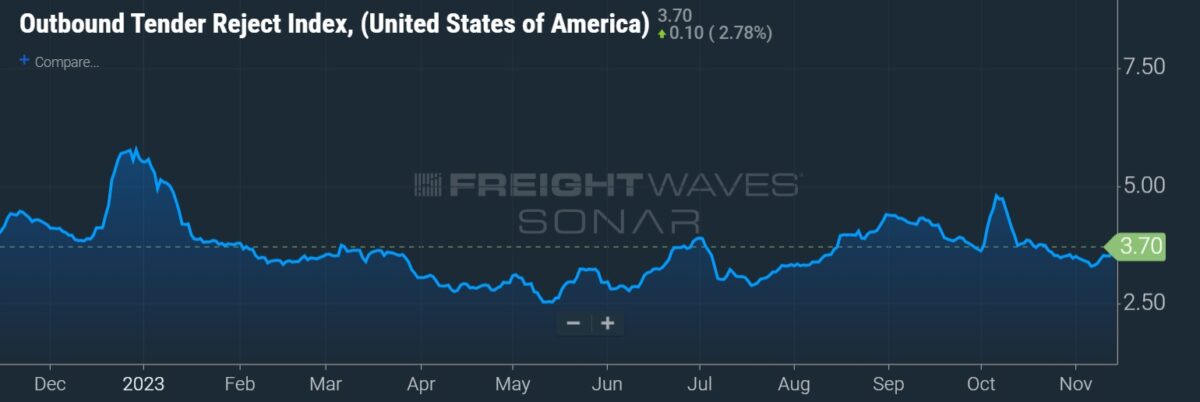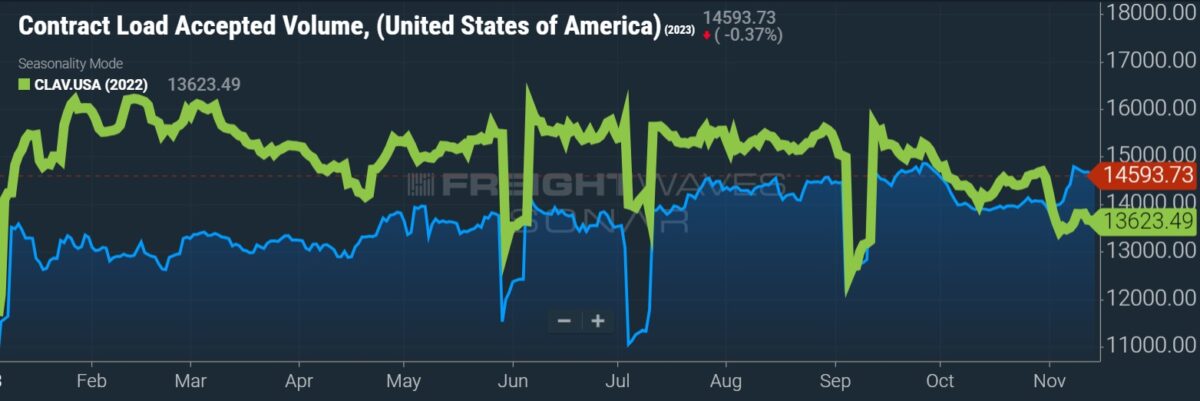Truckload carriers and 3PLs have seen little change in demand halfway through the fourth quarter, and some are pointing deeper into 2024 before the market corrects.
The comments came from heads of some of the largest publicly traded TL providers at Stephens 25th Annual Investment Conference in Nashville, Tennessee, on Tuesday. The sentiment aligns with a Tuesday report from freight payments platform Cass Information Systems (NASDAQ: CASS), which said October produced a cycle low for shipments.
Freight broker Landstar System (NASDAQ: LSTR) said the market is a little softer than it was at the end of October when it reported third-quarter earnings and provided fourth-quarter guidance. The company said it doesn’t expect a peak season this year.
“There’s no excitement out there — whether it’s the parcel carriers, the shippers — or anybody who thinks this thing is going turn anytime soon,” said Jim Gattoni, Landstar president and CEO.
He said sequential seasonal patterns have been lower than normal in every month of 2023. He reiterated the company’s fourth-quarter outlook but now expects results to shake out closer to the middle or the lower end of the range.
He doesn’t see spot rates stepping materially higher until next year and said that it usually takes better demand versus capacity attrition to move the market. Turnover among Landstar’s business capacity owners, a proxy for truck capacity, is 39% this year, which is in line with the 36% rate recorded during the 2019 downturn.
“We’re continuing to pull down,” Gattoni said about spot rates. “But I think by the time we get into 2024, maybe midsummer, we’ll start seeing regular seasonal patterns again.”


Management from TL carrier Werner Enterprises (NASDAQ: WERN) noted a “fairly muted” peak season. It said volumes have been steady to slightly better than last year’s peak but pricing has been weaker, resulting in lower revenue year over year (y/y).
The company has seen “no surprises to the negative” since its Nov. 1 earnings report. However, it noted the next four weeks are very important to the fourth-quarter result. Werner didn’t provide a pricing outlook for next year but said that its contract rates have already fully reset lower and an elevated cost structure means “there isn’t much to give” even as inflation moderates.
Werner’s fourth-quarter outlook calls for revenue per total mile in its one-way segment to be flat to slightly down from the third quarter but off 7% to 9% y/y. Revenue per truck per week in its dedicated unit is expected to finish 2023 flat to up 3% y/y. Werner said it will continue to focus on cost control but didn’t provide a time frame for an eventual turnaround.
“History has indicated that it won’t take much of a blip in demand along with the ongoing decrease in supply … . The ‘when’ is hard to say,” said Craig Callahan, Werner’s chief commercial officer.

Multimodal provider J.B. Hunt Transport Services (NASDAQ: JBHT) provided a more upbeat tone, at least for its intermodal segment.
The company has been seeing record intermodal volumes in its network in recent weeks, noting the unit is normally the one that first sees a turn when exiting a recession.
“We knew we were taking share,” said Shelley Simpson, J.B. Hunt president, when discussing the positive inflection that had just started to occur when it reported third-quarter results a month ago. “I don’t think we understood the magnitude of the share that we were taking.”
She said she was pleased with intermodal peak season but didn’t provide any direction on intermodal pricing. J.B. Hunt’s recent intermodal bid season concluded in the third quarter, and Simpson said “we’ll live with that pricing” during the fourth and first quarters. She believes it will take some time for the recent volume surge to push rates higher.
“We know what the inflation is and we’re not satisfied with our margins,” Simpson said. “Now we’re down to the timing of when can we get appropriate returns and appropriate price from our customers.”
Demand in the company’s truckload segments has been more reflective of a freight recession. However, its dedicated unit is seeing a slowdown in the number of accounts saying they need fewer trucks.
Most of its customers have worked through excess inventories, but they remain uncertain about future demand.
“Our customers don’t see a significant downturn,” Simpson said. “I think they feel OK about 2024. I think our customers are in a more neutral to slightly positive position.”
Schneider National (NYSE: SNDR) has also seen positive intermodal trends recently but categorized the broader freight market as “unseasonably tepid.”
“We did see a little bit of bounce as it relates to intermodal volumes, particularly in the month of October,” said Mark Rourke, president and CEO. “We need to see some staying power there before we claim any real victories.”
More FreightWaves articles by Todd Maiden
- October shipments hit cycle low, Cass says
- Forward’s new long-term targets don’t include Omni
- Annual LTL GRIs slightly ahead of schedule










